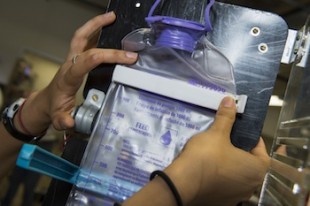
Rice University seniors have built a device to to ensure necessary fat contained in mothers' milk is reaching premature babies who have to be fed by tube. From left: Denizen Kocak, Nathan Liu, Alexa Juarez, Jane Jarjour and Mika Tabata. Photo by Jeff Fitlow
Rice University students’ invention ensures infants receive nutrients from mothers’ milk
BY PATRICK KURP
Special to the Rice News
Fat, the bane of many an adult, is precisely what babies born prematurely need to gain weight and grow strong and healthy. Some students at Rice University have invented a device to ensure preemies get enough fat, which has been a challenge.
Babies born more than five or six weeks before their due dates are unable to feed from a bottle or breast because they cannot coordinate sucking, breathing and swallowing. They must be tube-fed milk, but that too presents problems: Some 20 to 50 percent of the fat content in mother’s milk clings to the tubing and never reaches the child. Also lost are essential nutrients, including calcium, phosphorus and magnesium, that bind to the fat.

Nutriflow assures the flow of all of the nutrients in mothers' milk to premature infants by flapping the bag containing the milk to keep it mixed and flowing to ensure nutrients don't attach to the bag or tube. Photo by Jeff Fitlow
“Fat is essential for preemies, but it’s always been a problem getting it to them,” said Mika Tabata, a senior bioengineering student and a member of the design team Nutriflow at Rice. “Our task was to figure out a way to increase the amount of fat they receive, which has been difficult.”
Other team members are Alexa Juarez, Denizen Kocak and Nathan Liu, also senior bioengineering students, and Jane Jarjour, a senior majoring in biochemistry and cell biology.
Tabata first encountered the problem in 2013 while serving as a summer medical and research training intern at Baylor College of Medicine. There she worked with Steven Abrams, who researches the absorption and metabolism of dietary minerals in infants and children.
“We started out just using a stir-bar to mix the fat into the milk,” Liu said. “That showed a little improvement but not enough. We tried a sort of blender arrangement, but that stirred the milk too much. It was like churning butter.”

Nutriflow assures the flow of all of the nutrients in mothers' milk to premature infants by flapping the bag containing the milk to keep it mixed and flowing to ensure nutrients don't attach to the bag or tube. Photo by Jeff Fitlow
The breakthrough came when the team realized breast milk had to be mixed both in the feeding bag and the tubing. They devised a motorized panel programmed to give the plastic sack holding the milk three quick flips once every three minutes, the optimal rate for mixing. After repeated fine-tunings, calibrating the pump and the hinge, the team was able to assure that 95 percent of the fat in the milk could reach the child.
“We couldn’t believe it. After hours of hard work and going over the design, we finally hit the sweet spot,” Liu said.
Team Nutriflow won the Best Health-Related Engineering Design Award at the George R. Brown School of Engineering Design Showcase and Poster Competition on April 17. The research was done in collaboration with Abrams and Keli Hawthorne, a senior registered dietitian at Texas Children’s Hospital and Baylor College of Medicine.
The project was funded through Beyond Traditional Borders and made possible by a grant to Rice University from the Howard Hughes Medical Institute through the Undergraduate Science Education Program.

